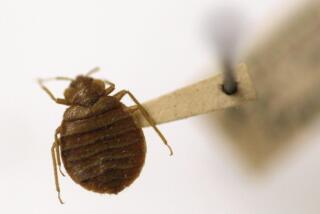Don’t let the bedbugs bite? That’s easier said than done lately
- Share via
The hotel room is clean, the bed neat. But you might be sharing it with a bedbug. Or two. Or 20.
Pest-control experts say bedbugs -- a.k.a. Cimex lectularius -- are making a comeback.
“Over the last year, we have seen a 21% higher incidence of bedbugs,” says Cindy Mannes, a spokeswoman for the National Pest Management Assn. in Fairfax, Va., a trade association. “It’s not just the hotel industry. We are really seeing them all over,” including in homes and college dorms.
Two cruise ships -- Royal Caribbean’s Jewel of the Seas and Carnival’s Victory -- had bedbug incidents this year.
On each ship, the nocturnal parasites were reported in one cabin, and cleaning and fumigation eliminated them, spokespersons said.
In Mathias vs. Accor Economy Lodging Inc., two plaintiffs sued an Illinois Motel 6, claiming they were bitten by bedbugs. In 2002 each was awarded $186,000 in punitive damages and $5,000 in compensatory damages. The motel appealed the judgment, but the bid was rejected by the 7th Circuit Court of Appeals.
Pest experts attribute the rising incidence of bedbugs to a resistance to pesticides and an increase in international travel.
The problem, at least in the U.S., is overstated, says Joe McInerney, president and chief executive of the American Hotel & Lodging Assn., a Washington, D.C.-based trade association.
“You definitely get them more overseas,” says Dr. David Sawcer, a professor of dermatology at USC’s Keck School of Medicine.
The wingless, apple-seed-sized insects are good travelers, hardy hitchhikers and fast runners, and they are sneaky. They can hide in wall cracks, dresser drawers and behind picture frames, then crawl back into bed once a warm body arrives. There they bite, in search of a blood meal, Sawcer says.
Their bites are more an ick factor than a health issue. “Although bedbugs certainly are nasty little critters and everyone gets the shivers when you mention them, they don’t really transmit disease,” says Tom Jones, a professor at the William F. Harrah College of Hotel Administration at the University of Nevada, Las Vegas. “They aren’t like ticks, [which] transmit Lyme disease.”
Bedbug bites resemble those from mosquitoes but usually appear in a row, Sawcer says. They typically disappear in a couple of days.
To treat the itching, cool the bite area with ice, he says, or apply a dab of over-the-counter hydrocortisone cream.
If you’ve been bitten while away, Sawcer advises washing clothes in hot water and inspecting luggage upon your return.
If you’re worried about encountering them, turn down the sheets and inspect the bed, though you still might not see them, says Brian Brown, the curator of entomology at the Natural History Museum of Los Angeles County. But you might see bloodstains on the sheets, a sign that bedbugs have checked in, he says.
If there are enough of them, their odor might give them away. “The bugs do have a distinctive smell,” Brown says. “It’s like a stinkbug smell.”
If the odor or more concrete evidence is there, change hotels, most experts say. If you can’t change hotels, ask for a room that is not adjacent, above or below the infested room, Mannes suggests.
If you must stay in the room, iron the sheets, says Dr. David Dassey, deputy chief of acute communicable diseases for the L.A. County Department of Health Services. The high temperature might kill them.
*
Healthy Traveler appears every other week. Kathleen Doheny can be reached at kathleendoheny@earthlink.net.
More to Read
Sign up for The Wild
We’ll help you find the best places to hike, bike and run, as well as the perfect silent spots for meditation and yoga.
You may occasionally receive promotional content from the Los Angeles Times.






